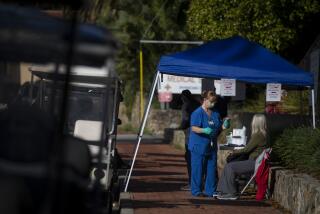Costs and Cutbacks Squeeze Hospital
With rising healthcare costs and decreasing reimbursement from government health programs, Community Hospital of San Bernardino is struggling to stay open.
The 418-bed facility serves about 30,000 people a year in a mostly low-income area of the city. It has lost almost $1 million per month for about two years, hospital officials said.
The hospital’s parent company, Catholic Healthcare West, is trying to change this, but its best chance of survival may come from the hospital’s medical staff, which is exploring ways to take over the facility to ensure it stays open.
“If they close this place down, there would be a lot of tragedies,” said Kin Tae Crawford, who was with a relative in the emergency room recently.
Crawford, 29, said residents in surrounding neighborhoods depend on Community Hospital for emergency and other healthcare needs, and that the hospital always has provided good care regardless of a patient’s ability to pay.
Community Hospital joins medical centers throughout Southern California that are suffering financially. In the last 14 months, six hospitals in Los Angeles County announced they would close their emergency rooms.
But Bruce Satzger, Community Hospital of San Bernardino president, said his hospital has no immediate plans to close its doors or its ER.
Increased malpractice insurance rates and higher labor costs have driven the hospital from being a profitable institution to being a money loser, he said. Satzger also attributed some of the problems to a dip in the amount of money coming in from Medi-Cal and Medicaid, the hospital’s main sources of revenue.
The hospital also treats a large number of uninsured patients, including illegal immigrants, who have no healthcare insurance coverage.
Federal grants to hospitals providing care to the needy also have been cut, Satzger said, causing a further strain. And California has the fourth-highest percentage of people without health insurance in the country -- 18.7% -- according to the Census Bureau.
Because Community Hospital of San Bernardino relies on government funding and is a general-care facility without specialty programs, there is little room for growth, Satzger said. The hospital may try to expand its maternity ward to generate more revenue, or lobby state and federal governments for assistance.
“If we are to provide care for anyone who walks in the door,” Satzger said, “we somehow need to have some sort of funding to cover that.”
The situation has left some concerned about the hospital’s future. San Bernardino County officials have discussed buying it as a last resort, but the county said it would not enter into a bidding war.
Doctors at the hospital are spearheading an effort that they say involves churches and others in the community to “return the hospital to the community,” according to Dr. Bharti Jain, the chief of staff. The hospital, more than 90 years old, has been operated by Catholic Healthcare West since 1998.
“We believe and have faith in this hospital, that it can survive,” Jain said.
Negotiations to take over the hospital might hit a snag, however, because of questions about the ownership. Representatives from Catholic Healthcare West said they own the San Bernardino hospital and hold the state regulating license. But attorney Charles Bond, who is representing the medical staff, said the hospital may be owned by the facility’s foundation, Community Hospital Foundation of San Bernardino, and merely operated by the healthcare company.
Whoever owns the hospital, both sides agree it cannot continue to lose money. Jain said the doctors’ plans could include expanding the obstetrics department and adding neurological care. She said the doctors’ financial advisors suggest the hospital can be turned around financially with little trouble.
“It is very doable,” Jain said.
Just when the hospital has taken a turn for the worse, its parent company has done the opposite. The not-for-profit Catholic Healthcare West has gone from being $54 million in the red for the fiscal year ending in 2002, to nearly $198 million in the black for the year ending in 2004.
But Satzger said location is a key to the success of hospitals. He said some of the other more than 40 facilities under the San Francisco-based company are in more prosperous areas and help balance the lower-earning locations.
County officials support the effort by the medical staff to take over the hospital, in part because that would allow the county to avoid taking it over.
“If there is a private solution,” said Supervisor Clifford Young, whose fifth district includes the hospital, “that ... should be looked at first prior to the county getting involved in it.”
The county will watch the situation, Young said, because the hospital remains a critical part of the region’s healthcare, and if it were to close it could affect other hospitals.
Some patients, like Krysti Anderson, do not want to go elsewhere. She spent three days in the hospital for an intestinal infection and said it is not available merely for low-income patients like herself, but has so far treated her better than other institutions.
The San Bernardino resident said she would have to wait for hours in waiting rooms at other hospitals and hopes Community Hospital continues to offer the same level of service.
“If they lose this hospital,” said Anderson, 30, “they lose a place that really takes care of people.”
More to Read
Sign up for Essential California
The most important California stories and recommendations in your inbox every morning.
You may occasionally receive promotional content from the Los Angeles Times.









